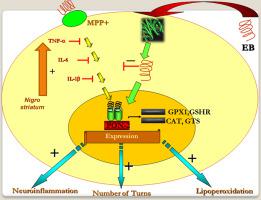当前位置:
X-MOL 学术
›
J. Neuroimmunol.
›
论文详情
Our official English website, www.x-mol.net, welcomes your feedback! (Note: you will need to create a separate account there.)
Protection induced by estradiol benzoate in the MPP+ rat model of Parkinson's disease is associated with the regulation of the inflammatory cytokine profile in the nigro striatum
Journal of Neuroimmunology ( IF 3.3 ) Pub Date : 2020-12-01 , DOI: 10.1016/j.jneuroim.2020.577426 Yoshajandith Aguirre-Vidal , Jorge Morales-Montor , Carmen T. Gómez de León , Pedro Ostoa-Saloma , Mariana Díaz-Zaragoza , Sergio Montes , Marcela Arteaga-Silva , Antonio Monroy-Noyola
Journal of Neuroimmunology ( IF 3.3 ) Pub Date : 2020-12-01 , DOI: 10.1016/j.jneuroim.2020.577426 Yoshajandith Aguirre-Vidal , Jorge Morales-Montor , Carmen T. Gómez de León , Pedro Ostoa-Saloma , Mariana Díaz-Zaragoza , Sergio Montes , Marcela Arteaga-Silva , Antonio Monroy-Noyola

|
Previously, we have demonstrated that β-estradiol-3-benzoate (EB) has a protective effect on the neurodegenerative experimental model of Parkinson's disease. The protective effect is through the induction of the expression of paraoxonase-2 (PON2) in the striatum. PON2 has proven to have antioxidant and anti-inflammatory activity, this protein has a beneficial effect in MPP+ model in rats decreasing the lipid peroxidation and the oxidative stress. Furthermore, the molecular effect and the pathway by which EB induces protection were not further pursued. This study shows the regulation by EB of the anti-inflammatory effect through the modulation of cytokines, antioxidant enzymes and PON2 in the rat striatum. Rats were gonadectomized and 30 days after were randomly assigned into four experimental groups; only vehicles (Control group); EB treatment (EB group); MPP+ injury (M group); EB plus MPP+ injured (EB/M group). EB treatment consisted of 100 μg of the drug administered every 48 h for 11 days. Results showed that EB (group EB/M) treatment decrease significantly (40%) the number of ipsilateral turns respect to the M group and prevents significantly the dopamine (DA) decreased induced by MPP+ (~75%). This results are correlate with a significant decrease in the level of lipid peroxidation (60%) of the EB/M group respect to the M group. The EB treatment showed protection against neurotoxicity induced with MPP+, this could be due to EB capacity to prevent the increase in the expression level of proinflammatory cytokines TNF-α, IL-1 and IL-6 induced by MPP+. While, TGF-β1 and TGF-β3 expression was reduced in the rats treated only with MPP+, in the rats of EB/M group the expression of both cytokines was increased. EB protective effect against MPP+ neurotoxicity is related to antioxidant effect of PON2, pro-inflammatory cytokines and GSHR but not to SOD2, catalase, GPX1 or GPX4.
中文翻译:

苯甲酸雌二醇对帕金森病 MPP+ 大鼠模型的保护作用与黑质纹状体炎性细胞因子谱的调节有关
此前,我们已经证明 β-雌二醇-3-苯甲酸酯 (EB) 对帕金森病的神经退行性实验模型具有保护作用。保护作用是通过诱导纹状体中对氧磷酶-2 (PON2) 的表达来实现的。PON2 已被证明具有抗氧化和抗炎活性,这种蛋白质在大鼠 MPP+ 模型中具有降低脂质过氧化和氧化应激的有益作用。此外,没有进一步研究 EB 诱导保护的分子效应和途径。该研究表明 EB 通过调节大鼠纹状体中的细胞因子、抗氧化酶和 PON2 来调节抗炎作用。大鼠进行性腺切除,30 天后随机分为四个实验组;仅车辆(对照组);EB治疗(EB组);MPP+损伤(M组);EB 加 MPP+ 受伤(EB/M 组)。EB 治疗由每 48 小时给药 100 μg 的药物组成,持续 11 天。结果表明,EB(EB/M 组)治疗显着(40%)相对于 M 组减少了同侧转动的数量,并显着防止了 MPP+ 诱导的多巴胺(DA)减少(~75%)。该结果与 EB/M 组相对于 M 组的脂质过氧化水平 (60%) 的显着降低相关。EB 治疗显示出对 MPP+ 诱导的神经毒性的保护作用,这可能是由于 EB 能够阻止 MPP+ 诱导的促炎细胞因子 TNF-α、IL-1 和 IL-6 表达水平的增加。而仅用 MPP+ 治疗的大鼠中 TGF-β1 和 TGF-β3 的表达降低,EB/M组大鼠两种细胞因子的表达均增加。EB 对 MPP+ 神经毒性的保护作用与 PON2、促炎细胞因子和 GSHR 的抗氧化作用有关,但与 SOD2、过氧化氢酶、GPX1 或 GPX4 无关。
更新日期:2020-12-01
中文翻译:

苯甲酸雌二醇对帕金森病 MPP+ 大鼠模型的保护作用与黑质纹状体炎性细胞因子谱的调节有关
此前,我们已经证明 β-雌二醇-3-苯甲酸酯 (EB) 对帕金森病的神经退行性实验模型具有保护作用。保护作用是通过诱导纹状体中对氧磷酶-2 (PON2) 的表达来实现的。PON2 已被证明具有抗氧化和抗炎活性,这种蛋白质在大鼠 MPP+ 模型中具有降低脂质过氧化和氧化应激的有益作用。此外,没有进一步研究 EB 诱导保护的分子效应和途径。该研究表明 EB 通过调节大鼠纹状体中的细胞因子、抗氧化酶和 PON2 来调节抗炎作用。大鼠进行性腺切除,30 天后随机分为四个实验组;仅车辆(对照组);EB治疗(EB组);MPP+损伤(M组);EB 加 MPP+ 受伤(EB/M 组)。EB 治疗由每 48 小时给药 100 μg 的药物组成,持续 11 天。结果表明,EB(EB/M 组)治疗显着(40%)相对于 M 组减少了同侧转动的数量,并显着防止了 MPP+ 诱导的多巴胺(DA)减少(~75%)。该结果与 EB/M 组相对于 M 组的脂质过氧化水平 (60%) 的显着降低相关。EB 治疗显示出对 MPP+ 诱导的神经毒性的保护作用,这可能是由于 EB 能够阻止 MPP+ 诱导的促炎细胞因子 TNF-α、IL-1 和 IL-6 表达水平的增加。而仅用 MPP+ 治疗的大鼠中 TGF-β1 和 TGF-β3 的表达降低,EB/M组大鼠两种细胞因子的表达均增加。EB 对 MPP+ 神经毒性的保护作用与 PON2、促炎细胞因子和 GSHR 的抗氧化作用有关,但与 SOD2、过氧化氢酶、GPX1 或 GPX4 无关。



























 京公网安备 11010802027423号
京公网安备 11010802027423号